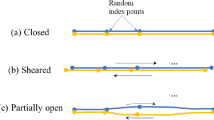Abstract
A plane flow through a porous medium in the neighborhood of a hydraulic fracture under the action of a potential difference applied between a well (sink) and an external electrode is considered. The problem of calculating the electric field and the induced flow through the porous medium is solved with allowance for the finite electric and hydraulic resistance of the fracture. The problem reduces to a system of singular integral equations for the distribution of the densities of hydraulic and electric sinks along the fracture. This is solved numerically, after which all the parameters of interest can readily be reconstructed. Calculation results illustrating the effect of the fracture resistance on the magnitude and distribution of the electroosmotic flow are given.
Similar content being viewed by others
References
D.A. Fridrikhcberg, Course of Colloid Chemistry (Khimiya, Leningrad 1984) [in Russian].
C.J. Bruell, B.A. Segall, and M.T. Walsh, “Electroosmotic Removal of Gasoline Hydrocarbons and TCE from Clay,” J. Environ. Eng. 118, No. 1, 68–74 (1992).
R.F. Probstein and R.E. Hicks, “Removal of Contaminants from Soils by Electric Field,” Science 260, No. 5107, 498–503 (1993).
A.P. Shapiro and R.F. Probstein, “Removal of Contaminants from Saturated Clays by Electroosmosis,” Environ. Sci. Tech. 27, 283–287 (1993).
Innovative Ground-Water Remediation Technologies: Publ. and Conf. Proc. 1990–1996 (http://www.epa.gov/tio/download/remed/gwbib.pdf).
J.I. Molho, A.E. Herr, T.W. Kenny, M.G. Mungal, P.M. St.John, M.G. Gargulio, P.H. Paul, M. Despande, and J.R. Gilbert, “Fluid TransportMechanisms in MicrofluidicDevices,” inMicro-Electro-Mechanical Systems (MEMS). 1998. Proc. ASME International Mech. Eng. Cong. and Exposition (DSC-V.66) (1998) (http://mems.stanford.edu/~aeh/publications/Molhoasme98.pdf).
H.A. Stone, A.D. Stroock, and A. Ajdari, “Engineering Flows in Small Devices: Microfluidics toward a Lab-on-a-Chip,” au]Annu. Rev. Fluid. Mech. 36, 381–411 (2004).
Fei Su, K. Chakrabarty, and R. B. Fair, “Microfluidics-Based Biochips: Technology Issues, Implementation Platforms, and Design-Automation Challenges,” IEEE Trans. on Computer-Aided Design of Integrated Circuits and Systems 25, No. 2, 211–223 (2006).
P.K. Wong, T.-H. Wang, J.H. Deval, and Ch.-M. Ho, “Electrokinetics in Microdevices for Biotechnology Applications,” IEEE—ASME Trans. on Mechatronics 9, No. 2, 366–376 (2004).
Groundwater and Soil Cleanup: Improving Management of Persistent Contaminants. Committee on Technologies for Cleanup of Subsurface Contaminants in the DOE Weapons Complex, National Research Council (1999) (http://fermat.nap.edu/catalog/9615.html).
S.V. Ho and P.H. Brodsky, “Integrated In-Situ Technology for Soil Remediation—the Lasagna Process,” in Amer. Chem. Soc. Annual Meeting, Atlanta, GA (1994), 505–506.
Lasagna™ Public-Private Partnership Completes Work (http://www.rtdf.org/PUBLIC/lasagna/lasag.pdf).
A.F. Zazovskii and G.T. Todua, “Steady Inflow into a Well with a Long Vertical Fracture,” Fluid Dynamics 25, 584–593 (1990).
V.M. Entov and P.M. Adler, “On Large-Scale Electrokinetic Phenomena in Natural Porous Media,” Preprint No. 754, (Inst. Probl. Mech. RAS, Moscow, 2004).
S.M. Belotserkovskii and I.K. Lifanov, Numerical Methods in Singular Equations and their Use in Aerodynamics, Elasticity Theory, and Electrodynamics, (Nauka, Moscow, 1985) [in Russian].
F.D. Gakhov, Boundary Value Problems (Nauka, Moscow, 1977) [in Russian].
N.I. Muskhelishvili, Singular Integral Equations (Nauka, Moscow, 1968) [in Russian].
L.C. Murdoch and J.-L. Chen, “Effect of Conductive Fractures during In-Situ Electroosmosis,” J. Hazardous Materials 55, Nos. 1–3, 239–262 (1997).
L. Murdoch, J.-L. Chen, P. Cluxton, M. Kemper, J. Anno, and D. Smith, Hydraulic Fractures as Subsurface Electrodes: Early Works on the Lasagna Process (http://www.p2pays.org/ref/37/36919.pdf).
Additional information
Original Russian Text © V.M. Entov, E.M. Chekhonin, 2007, published in Izvestiya Rossiiskoi Akademii Nauk, Mekhanika Zhidkosti i Gaza, 2007, Vol. 42, No. 3, pp. 134–144.
Rights and permissions
About this article
Cite this article
Entov, V.M., Chekhonin, E.M. Calculation of electroosmotic inflow to hydraulic fractures. Fluid Dyn 42, 453–462 (2007). https://doi.org/10.1134/S0015462807030131
Received:
Issue Date:
DOI: https://doi.org/10.1134/S0015462807030131




